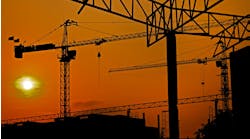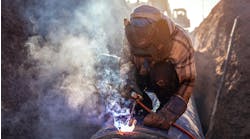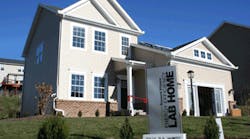OHIO TOWNSHIP, PA. — S&A Homes, based in State College, Pa.,
in partnership with Integrated Building and Construction Solutions (IBACOS), a Pittsburgh-based building sciences consulting firm, and its Best Practices Research Alliance, has built a near-zero energy Lab Home in Cobblestone Estates, Ohio Township, Pa., which is expected to pave the way toward eradicating homeowner's energy bills.
The four-bedroom, 2,772-sq.ft. Lab Home will serve as a life-sized laboratory over the next three years as multiple HVAC systems and building practices are monitored. Through collaboration on projects like this with Alliance members such as S&A Homes, IBACOS is pushing the limits of performance to make net-zero homes accessible to the average homeowner and affordable for a production homebuilder to build. That’s why the Lab Home is in a residential development typical for the area.
According to Kevin Brozyna of IBACOS, Lab Home project manager, the Lab Home achieves a greater than 67% energy efficiency over a typical home through its highly efficient enclosure and innovative systems, like a ground source heat pump.
Mechanical systems
The Lab Home utilizes both a vertical well loop system and a horizontal loop system for the ground source heat pump that heats and cools the house, and solar panels are also utilized to produce energy.
“Besides the traditional loops that run into deep wells, we’re also experimenting with a set-up in which we’ve installed a second set of loops under the foundation of the Lab Home to test their feasibility as an alternative to digging costly wells,” said Brozyna.
The geothermal well and sub-slab system were installed by Nittany Geothermal, State College, Pa., along with a ClimateMaster ground source heat pump.
According to Christopher Sylves, president/owner of Nittany Geothermal, two vertical bore hills 150-ft. deep were drilled, which took a day and a half and included drilling holes, grouting and installing the loop pipe. The sub-slab took almost a full day to install.
“The whole project itself is neat; from the geothermal standpoint, the sub-slab loop piping is pretty unique,” said Sylves. “When they approached me, I had reservations because the pipe in the sub-slab system is two feet below the slab. But the more I was exposed to this idea and the more data I looked at, the more excited I became. I’m anxious to see how this works out.”
The Lab Home gets some of its hot water from the ground source heat pump, which features an optional desuperheater attachment. It also has two backup Rheem Marathon electric water heaters.
“The plumbing itself is unique — it’s Uponor AquaPEX tubing, which has the advantage of retaining heat in hot water lines and resisting condensation in cold water lines better than traditional tubing,” said Brozyna.
The home’s HVAC system has three distribution systems, one traditional ductwork and two experimental systems: a PVC piping system and one of insulated duct board.
“The Lab Home is so energy efficient that less conditioned air is needed to make it comfortable, so we are researching which is the best air distribution option for homes of this kind,” explained Brozyna. “Our enclosure is also very tight, so we used an energy recovery ventilator, the UltimateAir RecoupAerator 200DX by Stirling Technology Inc., to circulate fresh air into the home.”
The Lab Home is also utilizing 16 250-Watt AC solar panels by Honeywell, located on the garage roof. Each panel, which functions in a battery-less grid-tied system, is an independent producer of energy with its own inverter.
When the panels produce more energy than the house needs, the excess is fed back to the grid.
The solar system is also scalable, so if a homeowner chooses, they could take the home further toward zero energy when solar is less cost-prohibitive.
According to Brozyna, energy generated from the solar panels on the garage roof raise the Lab Home’s energy efficiency to greater than 81%, and not only can that generated energy power the home, it can earn credit on utility bills.
Other technologies utilized are 8-in. thick exterior walls, achieving an R-40 rating through the use of staggered-stud framing, continuous XPS and housewrap on the exterior, spray foam in band joists and in penetrations to the interior and exterior, and blown-in fiberglass and drywall in the interior; and LED and CFL lighting to conserve energy.
Monitoring the home
To monitor the home’s systems there are more than 300 sensors of five different types embedded in the walls, floors, ceilings and systems that IBACOS will monitor. The systems will be monitored remotely and on-site to observe how they perform individually and together, in all weather and conditions, for three years while the house is unoccupied.
According to Dave Stecher of IBACOS, performance testing and monitoring specialist, part of this monitoring project is running simulations that will mimic the effects of a fully occupied home in a wide range of scenarios.
“In terms of HVAC specifically, sensors will monitor how well the different distribution systems perform, both in terms of the degree of comfort provided and in the thermal enclosure factors that influence the system’s success or failure,” said Stecher.
Monitored performance aspects will include the temperature of supplied air; air temperature around ceiling bulkheads and over-door grilles; the force and distance of the “throw” of air into different rooms; surface temperature of windows and walls; how well the newly conditioned air mixes with air already present in the rooms; radiant heat from surrounding surfaces; air temperature at 4-in, 24-in., 43-in., and 67-in. from floor; and relative humidity.
Designing, building the Lab Home
Because of S&A Homes’ dedication to innovation and energy efficiency through its E-Home, which debuted in 2009, the builder had the appropriate background to work on the Lab Home.
While not at net-zero, the S&A E-Home cuts the average homeowner's monthly energy bills by $150 when compared to similarly sized, 10-year-old homes. Some of the Energy Star qualified E-Home's features include high performance HVAC systems, ultra low-e windows, 90% CFL lighting and recycled materials. The E-Home also features a Manabloc water system and insulated ductwork to prevent heat and cooling loss.
"S&A has been dedicated to innovations over the last 20 years, and the Lab Home is simply the next step in the evolution towards achieving the ultimate in energy efficient homes," said Chris Schoonmaker, vice president of sales at S&A Homes. "We also understand that no matter how much a homebuyer wants to save on energy bills or help the environment, homes must be affordable, stylish and in the right location.
“With lessons learned from the Lab Home, we hope homebuyers everywhere will have the ability to move beyond our current E-Home standards to zero-energy lifestyles," added Schoonmaker.
Designing the Lab Home, including modeling, development, permitting, etc., took approximately 17 months, and construction was completed mid-October 2010.
“The main challenges of designing the Lab Home were the number of decisions that had to be made before construction began,” said Brozyna. “Those choices were based on making the home maximally efficient while also using materials and methods that were commercially available to a production homebuilder.”
Other challenges during the construction process included bringing the builder and other contractors who worked on the Lab Home up to speed on construction processes they weren’t familiar with.
“Keys to dealing with the construction challenges included spending time with the tradespeople, ensuring they understood the processes they were executing, and also making sure the Lab Home team was always on hand to supervise and answer questions,” said Brozyna.


